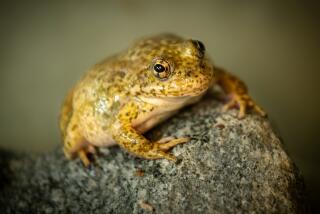Biologists move 500 red-legged frog eggs to mountain wetlands
Federal biologists clad in waders and armed with long-handled nets this week moved hundreds of red-legged frog eggs from a San Fernando Valley stream to carefully selected wetlands 10 miles away in the first attempt to expand the threatened speciesâ range in Southern California.
Five hundred eggs transported from the Upper Las Virgenes Canyon Open Space Preserve to the Santa Monica Mountains are expected to hatch any day. When they do, they will reintroduce red-legged frog tadpoles to historic haunts that are free of predatory fish, snails and crayfish that could tear them apart.
About two years from now, if all goes according to plan, the mating calls of the largest native frog west of the Mississippi will rejoin the natural sounds in remote mountainous terrain where the species has not been seen in nearly half a century.
The biologists were led by Katy Delaney of the Santa Monica Mountains National Recreation Area. She waded into a deep rocky pool shortly after sunrise Tuesday and used her fingers to gently coax portions of two submerged egg masses attached to willow branches into plastic containers.
âOoh! Theyâre wily little things!â she said with a nervous laugh, while trying to retrieve a couple of eggs that had slipped through her fingers and were floating downstream. âYouâre going to love your new home. Promise.â
The collaborative effort involving the National Park Service, the U.S. Geological Survey, the U.S. Fish and Wildlife Service and the Mountains Recreation and Conservation Authority aims to return the species, known to scientists as Rana draytonii, to some of the waterways where it thrived for hundreds of thousands of years.
Since the 1960s, the frog has been decimated by fires, mudslides, pesticides, fungal infections and loss of habitat, as well as the appetites of raccoons and nonnative fish, bullfrogs and crayfish. Today, it exists in about 30% of its historic range.
With skin as permeable as a sponge, the species is susceptible to a skin fungus that has wiped out amphibian populations around the world. The fungus swept through California in the 1960s and 1970s, killing millions of frogs and fragmenting survivors into isolated groups.
âThe few frog populations that survived â including these red-legged frogs â have somehow persisted with the disease,â Adam Backlin, a USGS field biologist, said. âThey seem to have figured out how to deal with it.â
âSo if this translocation effort works, weâll dispatch them to additional sites in Southern California,â Backlin said.
Moving frogs to conserve them in California has already re-established thriving populations in the Central Valleyâs Pinnacles National Park and the Bay Areaâs Golden Gate National Recreation Area.







